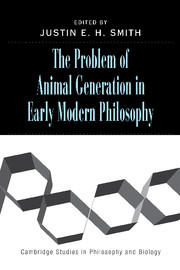Book contents
- Frontmatter
- Contents
- List of Contributors
- Introduction
- I THE DAWNING OF A NEW ERA
- II THE CARTESIAN PROGRAM
- III THE GASSENDIAN ALTERNATIVE
- IV SECOND-WAVE MECHANISM AND THE RETURN OF ANIMAL SOULS, 1650–1700
- 7 Animal Generation and Substance in Sennert and Leibniz
- 8 Spontaneous and Sexual Generation in Conway's Principles
- 9 Malebranche on Animal Generation: Preexistence and the Microscope
- 10 Animal as Category: Bayle's “Rorarius”
- V BETWEEN EPIGENESIS AND PREEXISTENCE: THE DEBATE INTENSIFIES, 1700–1770
- VI KANT AND HIS CONTEMPORARIES ON DEVELOPMENT AND THE PROBLEM OF ORGANIZED MATTER
- VII KANT AND THE BEGINNINGS OF EVOLUTION
- Bibliography
- Index
8 - Spontaneous and Sexual Generation in Conway's Principles
Published online by Cambridge University Press: 06 August 2009
- Frontmatter
- Contents
- List of Contributors
- Introduction
- I THE DAWNING OF A NEW ERA
- II THE CARTESIAN PROGRAM
- III THE GASSENDIAN ALTERNATIVE
- IV SECOND-WAVE MECHANISM AND THE RETURN OF ANIMAL SOULS, 1650–1700
- 7 Animal Generation and Substance in Sennert and Leibniz
- 8 Spontaneous and Sexual Generation in Conway's Principles
- 9 Malebranche on Animal Generation: Preexistence and the Microscope
- 10 Animal as Category: Bayle's “Rorarius”
- V BETWEEN EPIGENESIS AND PREEXISTENCE: THE DEBATE INTENSIFIES, 1700–1770
- VI KANT AND HIS CONTEMPORARIES ON DEVELOPMENT AND THE PROBLEM OF ORGANIZED MATTER
- VII KANT AND THE BEGINNINGS OF EVOLUTION
- Bibliography
- Index
Summary
INTRODUCTION
To philosophers such as Descartes, Hobbes, Hooke, and Boyle, mechanism seemed to have great promise for explaining all manner of natural phenomena. Yet later seventeenth-century philosophers were critical of mechanism and often appealed in their explanations to what a thoroughgoing mechanist would consider “occult” forces. This was particularly true in explanations of the generation of animals, where satisfying mechanical explanations were not forthcoming; for example, despite promises to explain animal generation, Descartes never did provide a worked-out account. One fascinating figure in the history of later seventeenth-century responses to mechanism is Anne Conway (1631–79). In her Principles of the Most Ancient and Modern Philosophy, Conway raises objections to the materialism of Hobbes and Spinoza and to the dualism of Descartes and Henry More. In the course of arguing for a monistic vitalism, she presents interesting views on animal generation. While Conway's monistic vitalism has recently received increasing attention in the secondary literature, the details of her views on generation have not been explored.
CONWAY'S ONTOLOGY
Anne Conway, née Finch, had gained an introduction to her half-brother's Cambridge tutor, Henry More, with whom she began corresponding in 1650. More guided her through Descartes' Principles of Philosophy; after Anne's marriage to Edward Conway in 1651, More and other Cambridge philosophers frequently visited the Conways' home, and Conway and More continued their correspondence. In 1670, More introduced Conway to Francis Mercury van Helmont, hoping that van Helmont could cure her chronic and very severe headaches.
- Type
- Chapter
- Information
- The Problem of Animal Generation in Early Modern Philosophy , pp. 175 - 193Publisher: Cambridge University PressPrint publication year: 2006
- 5
- Cited by



